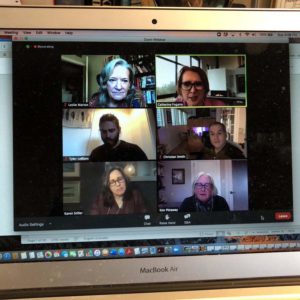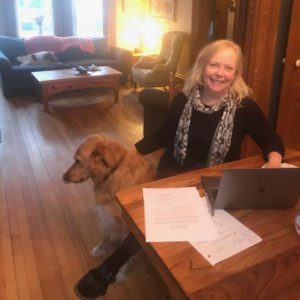Three faculty discuss the approaches they’ve developed to make online teaching work
When Fred Vallance-Jones learned he was going to be teaching his journalism courses online, he wasn’t sure exactly what form his lectures would take. But he knew right away what he didn’t want to do.
“I didn’t want to just talk over PowerPoints, because I wanted to be a real person there on this journey with the students—and not just this disembodied voice,” Vallance-Jones, an associate professor of journalism, said.
So instead of recording straight-up lectures, he is “trying to show people things. I’ve tried to make it a little more tactile.” Depending on the subject of the day, that might mean filming on the waterfront in Charlottetown, at Halifax Stanfield International Airport, or simply in front of a set of traffic lights.
Online, “You’re in a one-to-one relationship with someone who’s distant, and that immediately changes the relationship between students and teacher,” Vallance-Jones said. So instead of “exporting the classroom, I did it more like TV. I went out somewhere, and then I tied the class in to that place.”
Kim Pittaway, Executive Director of the MFA in Creative Nonfiction program, had to reimagine what not just one course, but a whole residency would look like. And she and her colleagues had to do it quickly.
King’s decided in mid-March that all classes would be held online for the coming year. That gave most professors the summer to get ready. But not the MFA faculty, who had “literally just finalized all the guests and plans for our in-person residency” running June 6 to 14, Pittaway said. “How do you completely reimagine what this event is going to be?”
The MFA program is low-residency, meaning students meet only twice a year. But the time they spend together is packed with mentorship sessions, lectures, readings, and social events. [Note: The writer of this article is a recent graduate of the program, and also assists with the online residencies.] How do you set about re-creating that atmosphere online?
“In the in-person version of the residency, people literally are going from nine o’clock in the morning, sometimes to 11 o’clock at night. That’s part of the magic of it—that there’s all of this stuff going on, you’re all in it together, and it’s immersive,” Pittaway said. “So we stood back from that and thought, what are the essential components? What’s reasonable to expect from our mentors and faculty, and from our students as well? We didn’t think people would want to be spending eight or 10 hours sitting in front of their computers.” They also had to take time zones into account, with faculty and students spread all the way from Tel Aviv to B.C.

Kim Pittaway and MFA alumni onscreen during a recent webinar.
The MFA faculty went with a mix of synchronous small-group sessions, asynchronous lectures and events that could be seen live or later. Pittaway said she was surprised by the level of response to the optional sessions. “We thought if we get 30 percent of students attending the optional stuff, we’d be happy. Instead, we got 90 or 95 percent of students attending most of the optional sessions live. And I was surprised by that.”
Assistant Professor Pauline Dakin said it was a bit of a shock to realize how radically she would have to change her journalism lectures. “You’re kidding me,” is how she reacted when she heard the ideal length of a video lecture is 10 to 15 minutes. “I pushed that; my lectures were more like 15 to 25,” she said.
For students in her audio workshop, Dakin says, “I was concerned about connecting with people. How do we replicate that on Zoom calls? But I am finding that for students who are engaged, it is possible… And that was a bit of a surprise. And the other kind of fun thing is that we’ve had people in different places, so that brings a different kind of layer to the programs that we do.”

Pauline Dakin with Teddy the Audio Dog.
Both Dakin and Vallance-Jones worry about the long-term sustainability of delivering their courses online. “I think we need to be conscious that there is an exhaustion level around all of this for everybody,” Dakin says. That’s true for us who are teaching, as well as those who are learning. We’re doing new things in new ways, and there’s a cognitive cost to that.”
Vallance-Jones agrees. “To do online teaching well, it’s a lot more work,” he said.
But it also has its benefits, some of which are likely to become incorporated into future teaching, even when classes take place in person again. “One upside of all this is that we are finding new ways to use technology to make things more doable. I expect some of that will survive,” Dakin said.
Pittaway said the MFA program has used technology as a way to hold events and keep students in touch between residencies, and she’d like to see that continue. “When we return to normal times…we expect that we will go back to doing the residencies in person,” Pittaway said. “But I also expect that we will continue to carry on some of the online components that our students have found beneficial.”
Banner photo is a screen shot of Fred Vallance-Jones’s final Advanced Reporting 1 class.

